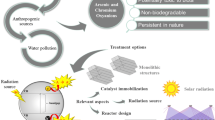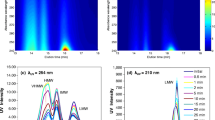Abstract
The present study aims to evaluate changes in the structure-composition of natural organic matter (NOM) that occur after the application of bubbleless ozonation or peroxone treatment of surface waters. The oxidation experiments (using 0.5–2 mg O3/mg DOC, or 2:1 O3:H2O2 molar ratio) were performed in a continuous mode, using a tubular ceramic membrane contactor. Fluorescence spectroscopy (emission-excitation matrix) and liquid chromatography-organic carbon detection (LC-OCD) were mainly used for the detailed DOC characterization. In brief, the application of single ozonation resulted to high reduction of humic-like peak fluorescence intensities (50–85%) and also to the formation of two new peaks in the region of protein-like components. The co-addition of H2O2 did not present the anticipated increase in the reduction of fluorescence intensity; however, it resulted to the further oxidation of protein-like fluorophores. LC-OCD measurements confirmed the decrease of average molecular weight of NOM during ozone treatment, due to the gradual degradation of biopolymers (14–23%) and humic substances (11–17%) towards building blocks and low molecular weight (LMW) neutrals. Advanced oxidation process (AOP) treatment by the mixture O3/H2O2 resulted in the simultaneous decrease of building blocks and LMW neutral concentrations. Conventional batch ozonation and AOP experiments were conducted using ozone-saturated solutions to investigate the effect of different contacting patterns. The results revealed that the different reaction pathways followed during bubbleless and conventional batch experiments may also influence the formation of NOM oxidation intermediates.






Similar content being viewed by others
References
Acero JL, Von Gunten U (2001) Characterization of oxidation processes: ozonation and the AOP O3/H2O2. Journal (American Water Works Association) 93:90–100
Atchariyawut S, Phattaranawik J, Leiknes T, Jiraratananon R (2009) Application of ozonation membrane contacting system for dye wastewater treatment. Sep Purif Technol 66:153–158. doi:10.1016/j.seppur.2008.11.011
Baghoth SA, Sharma SK, Guitard M, Heim V, Croué J-P, Amy GL (2011) Removal of NOM-constituents as characterized by LC-OCD and F-EEM during drinking water treatment. J Water Supply Res Technol AQUA 60:412–424. doi:10.2166/aqua.2011.059
Baker A, Inverarity R (2004) Protein-like fluorescence intensity as a possible tool for determining river water quality. Hydrol Process 18:2927–2945. doi:10.1002/hyp.5597
Bose P, Reckhow DA (2007) The effect of ozonation on natural organic matter removal by alum coagulation. Water Res 41:1516–1524. doi:10.1016/j.watres.2006.12.027
Boyer TH, Singer PC, Aiken GR (2008) Removal of dissolved organic matter by anion exchange: effect of dissolved organic matter properties. Environ Sci Technol 42:7431–7437. doi:10.1021/es800714d
Coble PG, Lead J, Baker A, Reynolds DM, Spencer RG (2014) Aquatic organic matter fluorescence. Cambridge University Press, New Hork
Drioli E, Criscuoli A, Curcio E (2006): Membrane contactors: fundamentals, applications and potentialities, 11. Elsevier, Amsterdam, Boston
Fellman JB, Hood E, Spencer RGM (2010) Fluorescence spectroscopy opens new windows into dissolved organic matter dynamics in freshwater ecosystems: a review. Limnol Oceanogr 55:2452–2462. doi:10.4319/lo.2010.55.6.2452
He W, Bai Z-L, Liu W-X, Kong X-Z, Yang B, Yang C, Jørgensen SE, Xu F-L (2016) Occurrence, spatial distribution, sources, and risks of polychlorinated biphenyls and heavy metals in surface sediments from a large eutrophic Chinese lake (Lake Chaohu). Environ Sci Pollut Res 23:10335–10348. doi:10.1007/s11356-015-6001-6
Heng S, Yeung KL, Djafer M, Schrotter J-C (2007) A novel membrane reactor for ozone water treatment. J Membr Sci 289:67–75. doi:10.1016/j.memsci.2006.11.039
Huber SA, Balz A, Abert M, Pronk W (2011) Characterisation of aquatic humic and non-humic matter with size-exclusion chromatography–organic carbon detection–organic nitrogen detection (LC-OCD-OND). Water Res 45:879–885. doi:10.1016/j.watres.2010.09.023
Janknecht P, Wilderer PA, Picard C, Larbot A (2001) Ozone–water contacting by ceramic membranes. Sep Purif Technol 25:341–346. doi:10.1016/S1383-5866(01)00061-2
Jansen RHS, de Rijk JW, Zwijnenburg A, Mulder MHV, Wessling M (2005) Hollow fiber membrane contactors—a means to study the reaction kinetics of humic substance ozonation. J Membr Sci 257:48–59. doi:10.1016/j.memsci.2004.07.038
Katsoyiannis IA, Canonica S, von Gunten U (2011) Efficiency and energy requirements for the transformation of organic micropollutants by ozone, O3/H2O2 and UV/H2O2. Water Res 45:3811–3822. doi:10.1016/j.watres.2011.04.038
Lamsal R, Walsh ME, Gagnon GA (2011) Comparison of advanced oxidation processes for the removal of natural organic matter. Water Res 45:3263–3269. doi:10.1016/j.watres.2011.03.038
Leiknes T, Phattaranawik J, Boller M, Gunten UV, Pronk W (2005) Ozone transfer and design concepts for NOM decolourization in tubular membrane contactor. Chem Eng J 111:53–61. doi:10.1016/j.cej.2005.05.007
Liu S, Lim M, Fabris R, Chow CWK, Drikas M, Korshin G, Amal R (2010) Multi-wavelength spectroscopic and chromatography study on the photocatalytic oxidation of natural organic matter. Water Res 44:2525–2532. doi:10.1016/j.watres.2010.01.036
Matilainen A, Sillanpää M (2010) Removal of natural organic matter from drinking water by advanced oxidation processes. Chemosphere 80:351–365. doi:10.1016/j.chemosphere.2010.04.067
Matilainen A, Gjessing ET, Lahtinen T, Hed L, Bhatnagar A, Sillanpää M (2011) An overview of the methods used in the characterisation of natural organic matter (NOM) in relation to drinking water treatment. Chemosphere 83:1431–1442. doi:10.1016/j.chemosphere.2011.01.018
Metreveli G, Abbt-Braun G, Frimmel FH (2010) Influence of NOM on the mobility of metal(loid)s in water-saturated porous media. Aquat Geochem 16:85–100. doi:10.1007/s10498-009-9071-6
Molnar J, Agbaba J, Dalmacija B, Tubić A, Krčmar D, Maletić S, Tomašević D (2013) The effects of matrices and ozone dose on changes in the characteristics of natural organic matter. Chem Eng J 222:435–443. doi:10.1016/j.cej.2013.02.087
Papageorgiou A, Papadakis N, Voutsa D (2016) Fate of natural organic matter at a full-scale drinking water treatment plant in Greece. Environ Sci Pollut R 23:1841–1851. doi:10.1007/s11356-015-5433-3
Papageorgiou A, Stylianou SK, Kaffes P, Zouboulis AI, Voutsa D (2017) Effects of ozonation pretreatment on natural organic matter and wastewater derived organic matter—possible implications on the formation of ozonation by-products. Chemosphere 170:33–40. doi:10.1016/j.chemosphere.2016.12.005
Park JW, Kim H-C, Meyer AS, Kim S, Maeng SK (2016) Influences of NOM composition and bacteriological characteristics on biological stability in a full-scale drinking water treatment plant. Chemosphere 160:189–198. doi:10.1016/j.chemosphere.2016.06.079
Peleato NM, Sidhu BS, Legge RL, Andrews RC (2017) Investigation of ozone and peroxone impacts on natural organic matter character and biofiltration performance using fluorescence spectroscopy. Chemosphere 172:225–233. doi:10.1016/j.chemosphere.2016.12.118
Pines DS, Min K-N, Ergas SJ, Reckhow DA (2005) Investigation of an ozone membrane contactor system. Ozone Sci Eng 27:209–217. doi:10.1080/01919510590945750
Pisarenko AN, Stanford BD, Yan D, Gerrity D, Snyder SA (2012) Effects of ozone and ozone/peroxide on trace organic contaminants and NDMA in drinking water and water reuse applications. Water Res 46:316–326. doi:10.1016/j.watres.2011.10.021
Rodríguez FJ, Marcos LA, Núñez LA, García M (2012) Effects of ozonation on molecular weight distribution of humic substances and coagulation processes—a case study: the Úzquiza reservoir water. Ozone Sci Eng 34:342–353. doi:10.1080/01919512.2012.710874
Rosenfeldt EJ, Linden KG, Canonica S, von Gunten U (2006) Comparison of the efficiency of OH radical formation during ozonation and the advanced oxidation processes O3/H2O2 and UV/H2O2. Water Res 40:3695–3704. doi:10.1016/j.watres.2006.09.008
Shanbhag PV, Guha AK, Sirkar KK (1998) Membrane-based ozonation of organic compounds. Ind Eng Chem Res 37:4388–4398. doi:10.1021/ie980182u
Sharp EL, Parsons SA, Jefferson B (2006) Seasonal variations in natural organic matter and its impact on coagulation in water treatment. Sci Total Environ 363:183–194. doi:10.1016/j.scitotenv.2005.05.032
Song Y, Liu R, Sun Y, Lei K, Kolditz O (2015) Waste water treatment and pollution control in the Liao River Basin. Environ Earth Sci 73:4875–4880. doi:10.1007/s12665-015-4333-7
Stedmon CA, Bro R (2008) Characterizing dissolved organic matter fluorescence with parallel factor analysis: a tutorial. Limnol Oceanogr Methods 6:572–579. doi:10.4319/lom.2008.6.572b
Stylianou SK, Sklari SD, Zamboulis D, Zaspalis VT, Zouboulis AI (2015a) Development of bubble-less ozonation and membrane filtration process for the treatment of contaminated water. J Membr Sci 492:40–47. doi:10.1016/j.memsci.2015.05.036
Stylianou SK, Szymanska K, Katsoyiannis IA, Zouboulis AI (2015b) Novel water treatment processes based on hybrid membrane-ozonation systems: a novel ceramic membrane contactor for bubbleless ozonation of emerging micropollutants. Journal of Chemistry 2015:12. doi:10.1155/2015/214927
Stylianou SK, Kostoglou M, Zouboulis AI (2016) Ozone mass transfer studies in a hydrophobized ceramic membrane contactor: experiments and analysis. Ind Eng Chem Res 55:7587–7597. doi:10.1021/acs.iecr.6b01446
Świetlik J, Sikorska E (2004) Application of fluorescence spectroscopy in the studies of natural organic matter fractions reactivity with chlorine dioxide and ozone. Water Res 38:3791–3799. doi:10.1016/j.watres.2004.06.010
Świetlik J, Dąbrowska A, Raczyk-Stanisławiak U, Nawrocki J (2004) Reactivity of natural organic matter fractions with chlorine dioxide and ozone. Water Res 38:547–558. doi:10.1016/j.watres.2003.10.034
Szymanska K, Zouboulis AI, Zamboulis D (2014) Hybrid ozonation–microfiltration system for the treatment of surface water using ceramic membrane. J Membr Sci 468:163–171. doi:10.1016/j.memsci.2014.05.056
Tian J-Y, Ernst M, Cui F, Jekel M (2013) Correlations of relevant membrane foulants with UF membrane fouling in different waters. Water Res 47:1218–1228. doi:10.1016/j.watres.2012.11.043
Uyguner CS, Bekbolet M (2005) Evaluation of humic acid photocatalytic degradation by UV–vis and fluorescence spectroscopy. Catal Today 101:267–274. doi:10.1016/j.cattod.2005.03.011
von Gunten U (2003) Ozonation of drinking water: part I. Oxidation kinetics and product formation. Water Res 37:1443–1467. doi:10.1016/S0043-1354(02)00457-8
von Sonntag C, von Gunten U (2012) Chemistry of ozone in water and wastewater treatment. IWA Publishing, London
Zhang T, Lu J, Ma J, Qiang Z (2008) Fluorescence spectroscopic characterization of DOM fractions isolated from a filtered river water after ozonation and catalytic ozonation. Chemosphere 71:911–921. doi:10.1016/j.chemosphere.2007.11.030
Zhang H, Jiang M, Zhang D, Xia Q (2009) Decomposition of 4-nitrophenol by ozonation in a hollow fiber membrane reactor. Chem Eng Commun 197:377–386. doi:10.1080/00986440903089031
Zhang S, Shao T, Karanfil T (2011) The effects of dissolved natural organic matter on the adsorption of synthetic organic chemicals by activated carbons and carbon nanotubes. Water Res 45:1378–1386. doi:10.1016/j.watres.2010.10.023
Acknowledgements
The financial support from the project of Research Committee of Aristotle University of Thessaloniki for support of new lecturers is greatly appreciated. Part of the project was executed through the activities of IKYDA 2016 bilateral Greek-German Research Project.
Author information
Authors and Affiliations
Corresponding author
Additional information
Responsible editor: VÃtor Pais Vilar
Rights and permissions
About this article
Cite this article
Stylianou, S.K., Katsoyiannis, I.A., Ernst, M. et al. Impact of O3 or O3/H2O2 treatment via a membrane contacting system on the composition and characteristics of the natural organic matter of surface waters. Environ Sci Pollut Res 25, 12246–12255 (2018). https://doi.org/10.1007/s11356-017-9554-8
Received:
Accepted:
Published:
Issue Date:
DOI: https://doi.org/10.1007/s11356-017-9554-8




